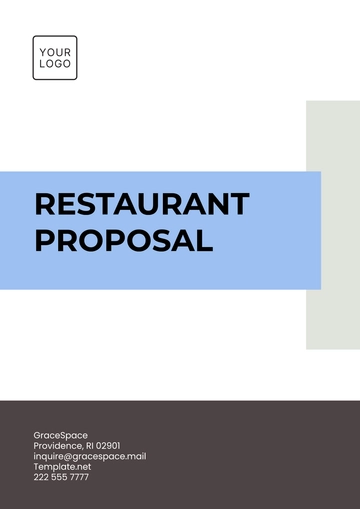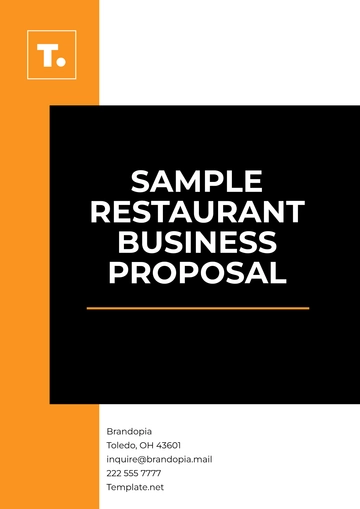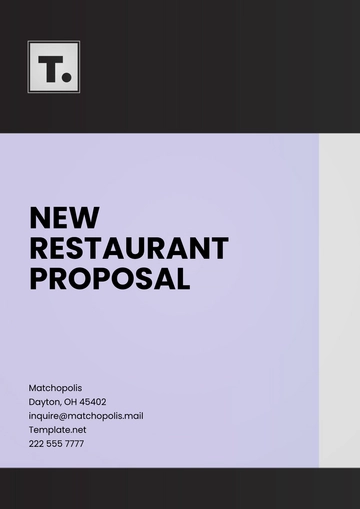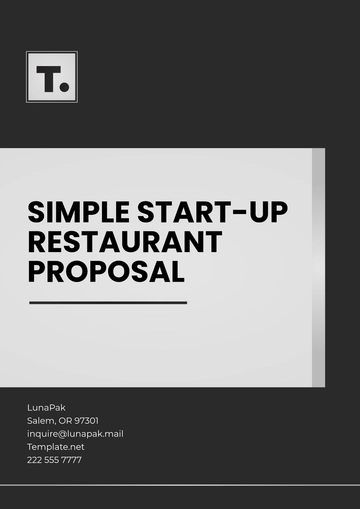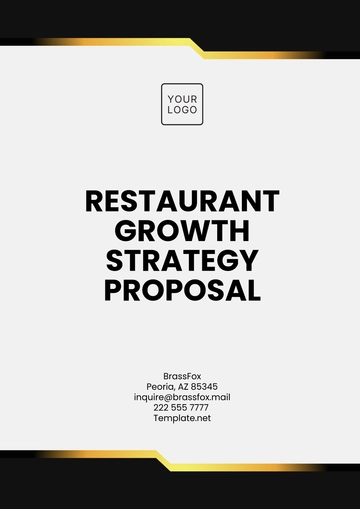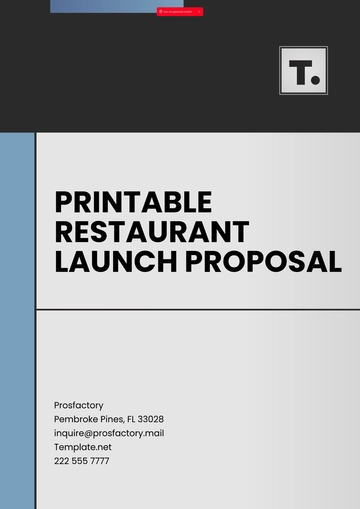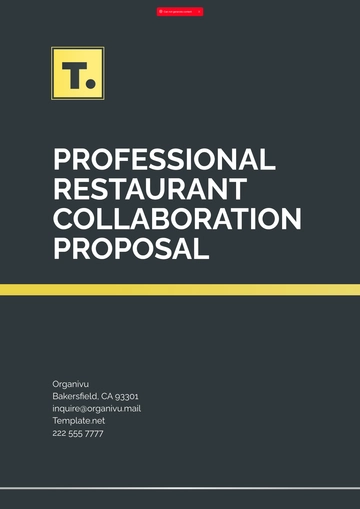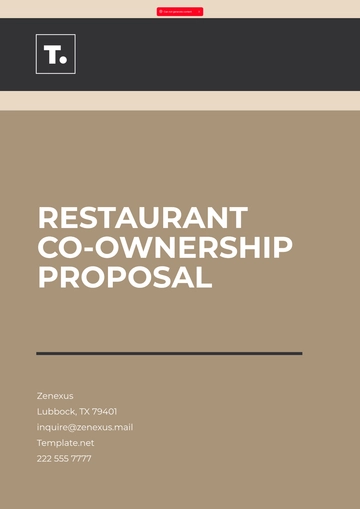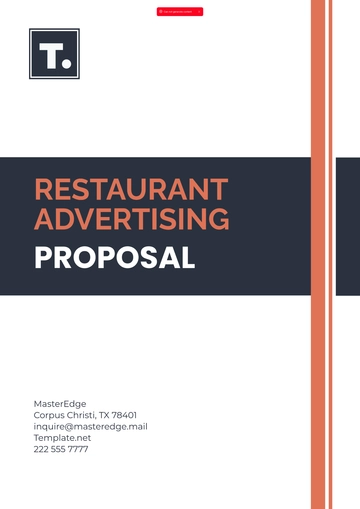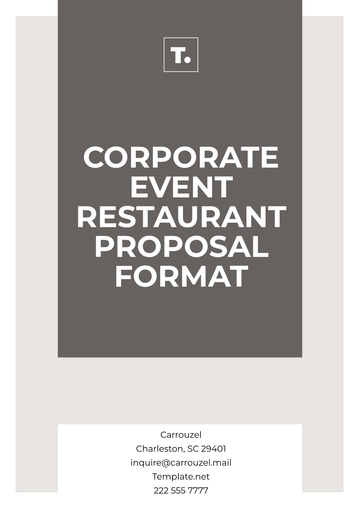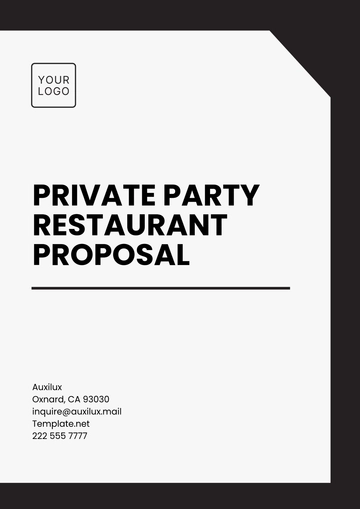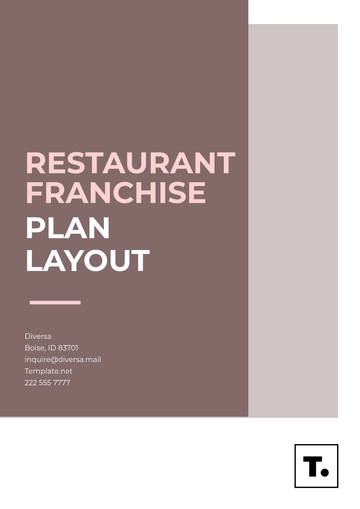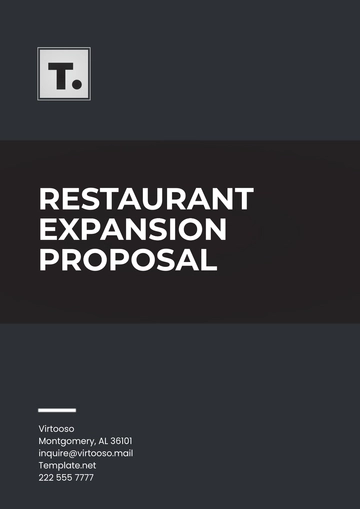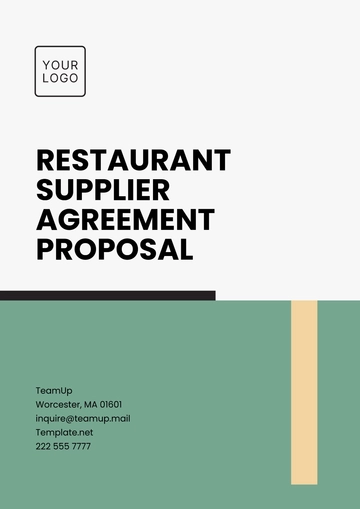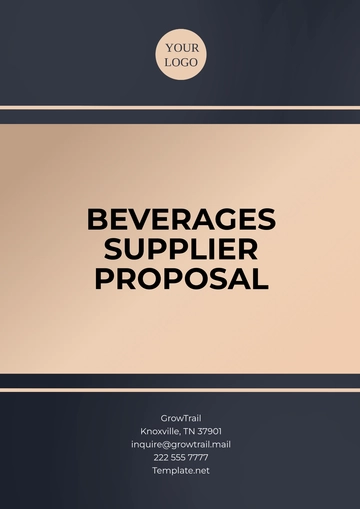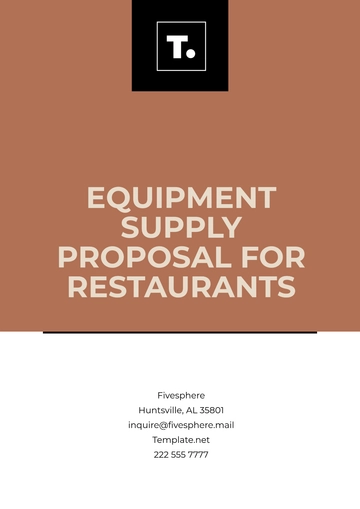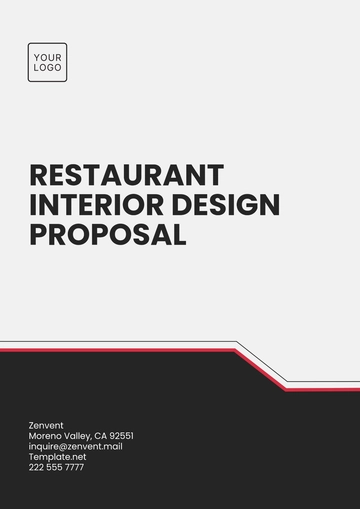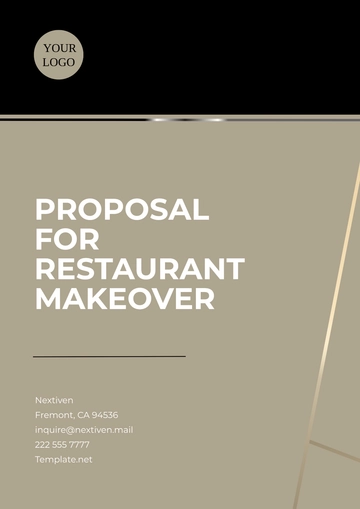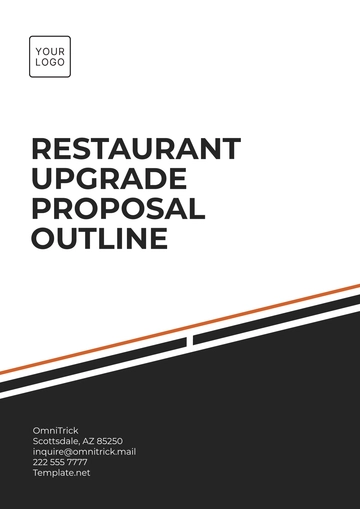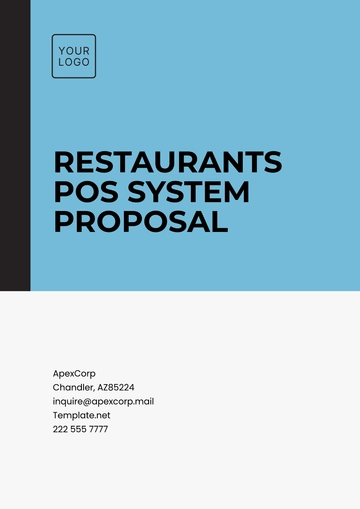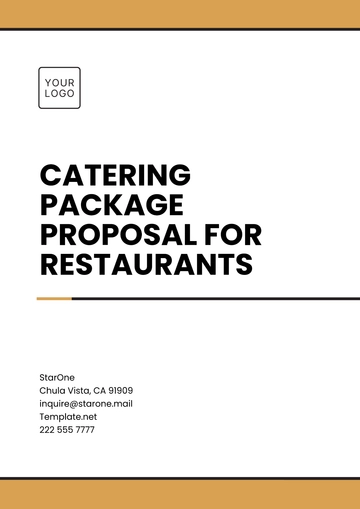Free Restaurant Management Proposal
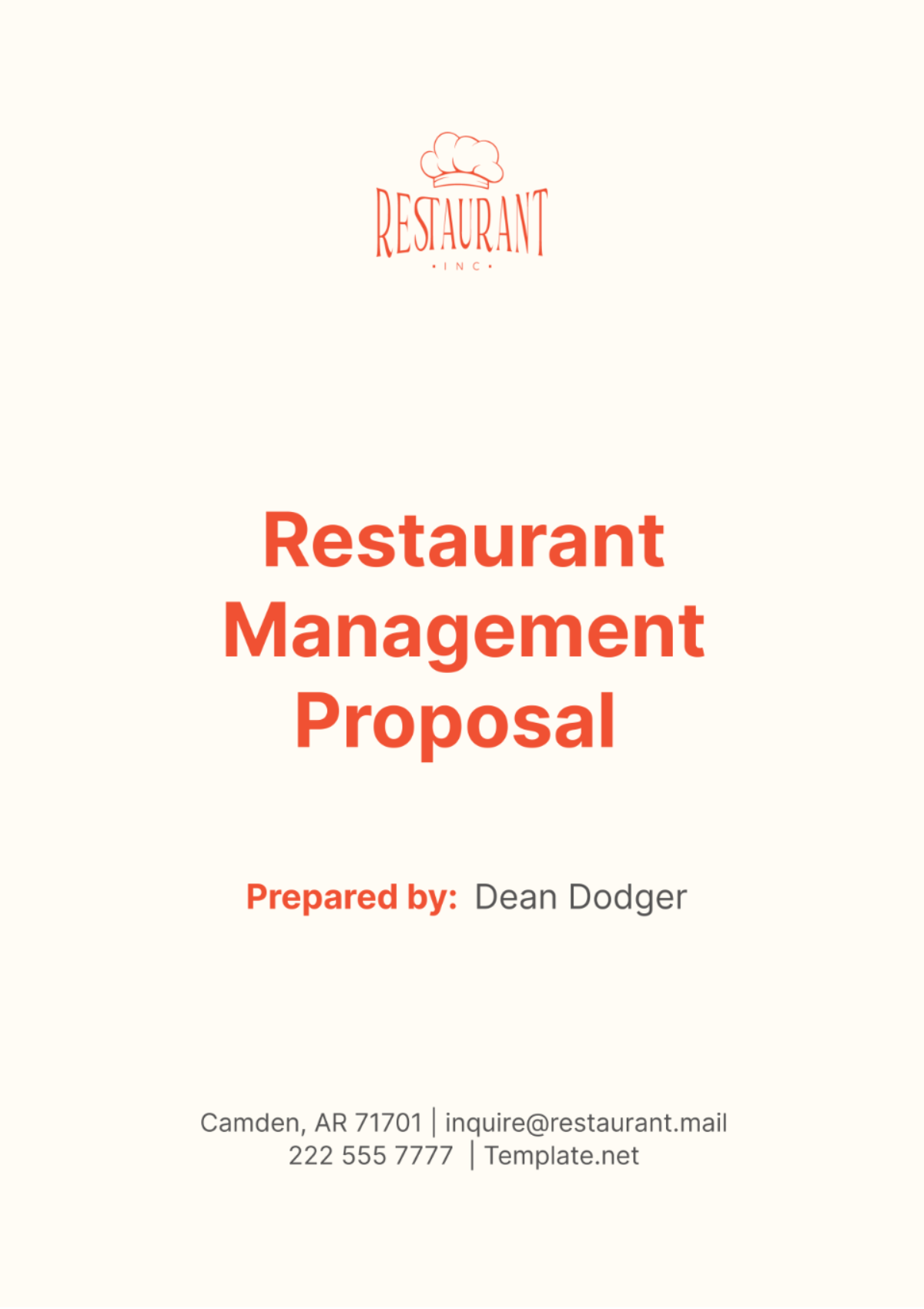
1. Introduction
[Your Company Name], a reputable and well-established dining establishment, has been consistently delighting its patrons with high-quality culinary offerings for [Number of Years]. In an ever-changing and increasingly competitive restaurant industry, it becomes imperative for [Your Company Name] to continually adapt and refine its management strategies to uphold and extend its market presence. This proposal is designed to meticulously detail a strategic plan aimed at augmenting the restaurant’s management framework, operational processes, and general business efficacy, thereby ensuring sustained growth and success in the industry.
2. Background
[Your Company Name] has been successful in delivering exceptional dining experiences to its customers. However, recent challenges such as increasing competition, rising costs, and changing customer preferences have highlighted the need for a more efficient and strategic management approach. The current management structure has served the restaurant well, but there is a need for a more streamlined and effective system to address these challenges.
3. Objectives
The primary objectives of this proposal are:
3.1 Streamline Management Structure
To restructure the management team to improve communication, decision-making, and overall efficiency. This includes clarifying roles and responsibilities, establishing clear reporting lines, and ensuring that each member of the management team has the necessary authority to carry out their duties effectively.
3.2 Enhance Operational Efficiency
To implement new operational procedures and systems that improve efficiency, reduce waste, and streamline processes. This includes optimizing kitchen operations, improving inventory management, and enhancing customer service protocols.
3.3 Improve Customer Satisfaction
To enhance the overall dining experience for customers by improving food quality, service standards, and overall ambiance. This includes training staff to provide exceptional service, implementing quality control measures, and soliciting feedback from customers to identify areas for improvement.
3.4 Increase Revenue and Profitability
To implement marketing strategies and revenue optimization measures that increase sales and profitability. This includes launching targeted marketing campaigns, introducing new menu items, and exploring new revenue streams such as catering services or special events.
3.5 Ensure Financial Sustainability
To develop a comprehensive financial plan that ensures the long-term financial sustainability of [Your Company Name]. This includes budgeting, cost control measures, and financial forecasting to ensure that the restaurant remains profitable and financially stable in the long run.
By achieving these objectives, [Your Company Name] will be better positioned to achieve its overall goal of becoming a leading restaurant in the industry, known for its exceptional food, service, and overall dining experience.
4. Proposed Management Structure
The proposed management structure for [Your Company Name] is as follows:
Position | Responsibilities |
|---|---|
CEO/Owner | Overall strategic direction and decision-making. |
General Manager | Day-to-day operations management and staff supervision. |
Head Chef | Menu planning, food quality control, and kitchen management. |
Restaurant Manager | Customer service, reservations, and overall guest experience. |
Marketing Manager | Marketing strategy development and promotional activities. |
Finance Manager | Financial planning, budgeting, and cost control. |
This new structure aims to streamline decision-making processes, improve communication between departments, and ensure that each area of the restaurant is managed effectively.
5. Management Team
The proposed management team for [Your Company Name] comprises individuals with extensive experience and expertise in their respective fields:
Position | Name | Experience and Qualifications |
|---|---|---|
CEO/Owner | [Name] has over 20 years of experience in the restaurant industry, including owning and managing several successful restaurants. He is known for his strategic vision and leadership skills. | |
General Manager | [Name]has been working in the restaurant industry for over 15 years, with experience in operations management and customer service. She has a proven track record of improving efficiency and customer satisfaction in her previous roles. | |
Head Chef | [Name] is a seasoned chef with a passion for creating innovative and delicious dishes. He has worked in several high-end restaurants and has received numerous awards for his culinary creations. | |
Restaurant Manager | [Name] has over 10 years of experience in restaurant management, with a strong focus on customer service and team leadership. She has a reputation for creating a warm and welcoming atmosphere for guests. | |
Marketing Manager | [Name] is a marketing expert with a background in digital marketing and brand management. He has worked with several well-known brands in the hospitality industry and has a track record of driving sales and brand awareness. | |
Finance Manager | [Name] is a finance professional with experience in budgeting, financial planning, and cost control. She has worked in the restaurant industry for over 8 years and has a strong understanding of the financial aspects of running a restaurant. |
Each member of the management team brings unique skills and insights that will contribute to the success of [Your Company Name].
6. Key Strategies
6.1 Operational Strategies
[Your Company Name] will implement the following operational strategies to enhance efficiency and customer satisfaction:
Streamlined Processes: Implementing standardized operating procedures to streamline kitchen operations, improve order accuracy, and reduce wait times.
Training and Development: Providing regular training and development opportunities for staff to enhance their skills and improve service quality.
Inventory Management: Implementing an inventory management system to track inventory levels, reduce waste, and optimize purchasing decisions.
Technology Integration: Implementing technology solutions such as POS systems and online ordering platforms to improve order accuracy and customer convenience.
Quality Control: Implementing stringent quality control measures to ensure that food quality meets or exceeds customer expectations.
6.2 Marketing Strategies
[Your Company Name] will implement the following marketing strategies to increase visibility and attract more customers:
Digital Marketing: Implementing a digital marketing strategy to enhance online presence through social media, email marketing, and online advertising.
Customer Loyalty Programs: Introducing customer loyalty programs to reward repeat customers and encourage customer retention.
Local Partnerships: Partnering with local businesses and organizations to increase brand visibility and attract new customers.
Promotional Campaigns: Launching promotional campaigns and special offers to attract new customers and drive sales.
Community Engagement: Engaging with the local community through events, sponsorships, and charity initiatives to build brand loyalty and goodwill.
6.3 Financial Strategies
[Your Company Name] will implement the following financial strategies to improve profitability and manage costs:
Cost Control Measures: Implementing cost control measures to reduce expenses without compromising on quality.
Revenue Optimization: Identifying new revenue streams and opportunities to increase revenue, such as catering services or special events.
Financial Planning: Developing a comprehensive financial plan to forecast revenue and expenses and ensure financial sustainability.
Budgeting: Implementing a budgeting process to allocate resources effectively and track financial performance.
Risk Management: Identifying and mitigating financial risks to protect the restaurant's financial health.
7. Implementation Plan
The implementation of the proposed management changes and strategies will be carried out in the following phases:
Phase | Timeline | Description |
|---|---|---|
Phase 1: Planning | Month 1 | Conduct a thorough analysis of the current management structure and operations to identify areas for improvement. Develop a detailed implementation plan outlining specific goals, timelines, and responsibilities. |
Phase 2: Implementation | Months 2-6 | Implement the proposed management changes and strategies, including restructuring the management team, implementing new operational procedures, and launching marketing campaigns. Provide training and support to staff to ensure a smooth transition. |
Phase 3: Monitoring and Evaluation | Months 7-12 | Monitor the performance of the new management structure and strategies, and evaluate their effectiveness in achieving the desired outcomes. Make adjustments as necessary to optimize performance. |
This table provides a clear overview of the timeline and key activities for each phase of the implementation plan for the proposed management changes and strategies at [Your Company Name].
8. Budget
The estimated budget for implementing the proposed management changes and strategies is as follows:
Category | Estimated Cost |
|---|---|
Operational Improvements | $25,000 |
Marketing Campaigns | $15,000 |
Training and Development | $10,000 |
Technology Integration | $20,000 |
Other Expenses | $5,000 |
Total | $75,000 |
Operational Improvements: This includes costs associated with implementing new operational procedures and systems, such as kitchen upgrades, equipment purchases, and staff training.
Marketing Campaigns: This includes costs associated with marketing strategies and campaigns, such as advertising, promotions, and branding efforts.
Training and Development: This category includes costs associated with training programs and development initiatives for staff to enhance their skills and improve service quality.
Technology Integration: This includes costs associated with integrating new technology solutions, such as POS systems, online ordering platforms, and customer management systems.
Other Expenses: This includes any additional expenses not covered in the above categories, such as legal fees, consulting services, and contingency funds.
The total estimated cost for implementing the proposed management changes and strategies is $75,000. This budget has been carefully planned to ensure that [Your Company Name] can achieve its goals of improving efficiency, enhancing customer satisfaction, and increasing profitability while maintaining financial sustainability.
9. Expected Outcomes
The expected outcomes of implementing the proposed management changes and strategies include:
Improved Efficiency: Streamlined processes and improved operational efficiency, resulting in faster service and reduced wait times.
Enhanced Customer Satisfaction: Better quality control and customer service, lead to increased customer satisfaction and loyalty.
Increased Revenue: Implementation of marketing strategies and revenue optimization measures to increase sales and profitability.
Cost Savings: Implementation of cost control measures and efficient resource allocation to reduce expenses and improve profitability.
Stronger Financial Position: Better financial planning and management to ensure the long-term financial sustainability of [Your Company Name].
10. Conclusion
The management revisions and strategic approaches detailed within this proposal are specifically tailored to improve and refine the management and operational frameworks at [Your Company Name]. Through the adoption of these suggested changes, it is projected that [Your Company Name] will not only strengthen its capacity to adapt to the changing demands of its clientele but will also enhance its operational efficacy. These enhancements are crucial for [Your Company Name] to secure continued growth, achieve long-term success, and maintain a competitive edge within the dynamic restaurant industry.
- 100% Customizable, free editor
- Access 1 Million+ Templates, photo’s & graphics
- Download or share as a template
- Click and replace photos, graphics, text, backgrounds
- Resize, crop, AI write & more
- Access advanced editor
Present your management services effectively with Template.net's Restaurant Management Proposal Template. This customizable and editable template, accessible through the Ai Editor Tool, enables you to outline your management approach, services offered, and pricing structure clearly. Impress potential clients with a professional proposal tailored to the restaurant industry. Highlight your experience in managing restaurants, your innovative strategies for improving operations, and your commitment to delivering exceptional results.
You may also like
- Business Proposal
- Research Proposal
- Proposal Request
- Project Proposal
- Grant Proposal
- Photography Proposal
- Job Proposal
- Budget Proposal
- Marketing Proposal
- Branding Proposal
- Advertising Proposal
- Sales Proposal
- Startup Proposal
- Event Proposal
- Creative Proposal
- Restaurant Proposal
- Blank Proposal
- One Page Proposal
- Proposal Report
- IT Proposal
- Non Profit Proposal
- Training Proposal
- Construction Proposal
- School Proposal
- Cleaning Proposal
- Contract Proposal
- HR Proposal
- Travel Agency Proposal
- Small Business Proposal
- Investment Proposal
- Bid Proposal
- Retail Business Proposal
- Sponsorship Proposal
- Academic Proposal
- Partnership Proposal
- Work Proposal
- Agency Proposal
- University Proposal
- Accounting Proposal
- Real Estate Proposal
- Hotel Proposal
- Product Proposal
- Advertising Agency Proposal
- Development Proposal
- Loan Proposal
- Website Proposal
- Nursing Home Proposal
- Financial Proposal
- Salon Proposal
- Freelancer Proposal
- Funding Proposal
- Work from Home Proposal
- Company Proposal
- Consulting Proposal
- Educational Proposal
- Construction Bid Proposal
- Interior Design Proposal
- New Product Proposal
- Sports Proposal
- Corporate Proposal
- Food Proposal
- Property Proposal
- Maintenance Proposal
- Purchase Proposal
- Rental Proposal
- Recruitment Proposal
- Social Media Proposal
- Travel Proposal
- Trip Proposal
- Software Proposal
- Conference Proposal
- Graphic Design Proposal
- Law Firm Proposal
- Medical Proposal
- Music Proposal
- Pricing Proposal
- SEO Proposal
- Strategy Proposal
- Technical Proposal
- Coaching Proposal
- Ecommerce Proposal
- Fundraising Proposal
- Landscaping Proposal
- Charity Proposal
- Contractor Proposal
- Exhibition Proposal
- Art Proposal
- Mobile Proposal
- Equipment Proposal
- Student Proposal
- Engineering Proposal
- Business Proposal
